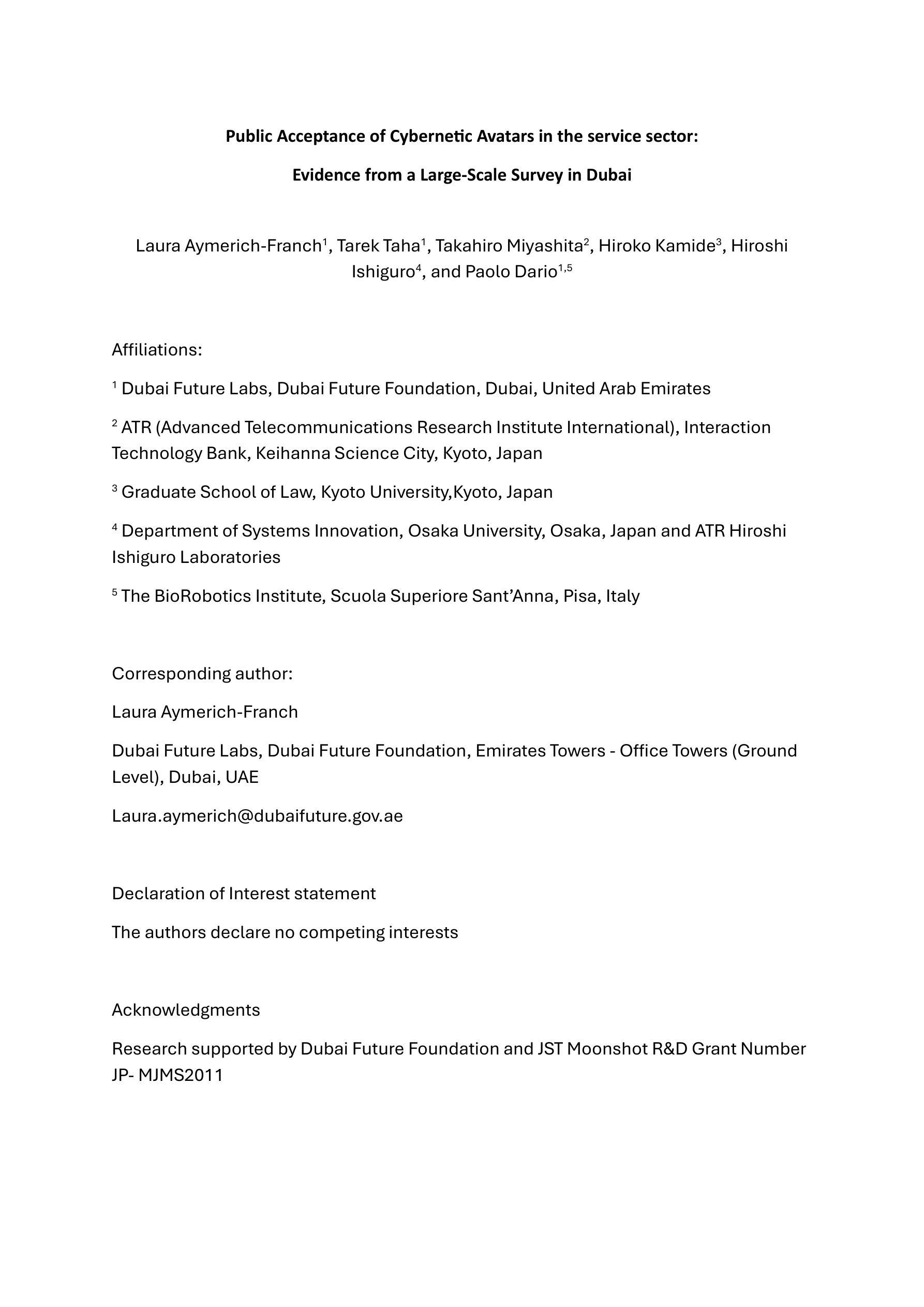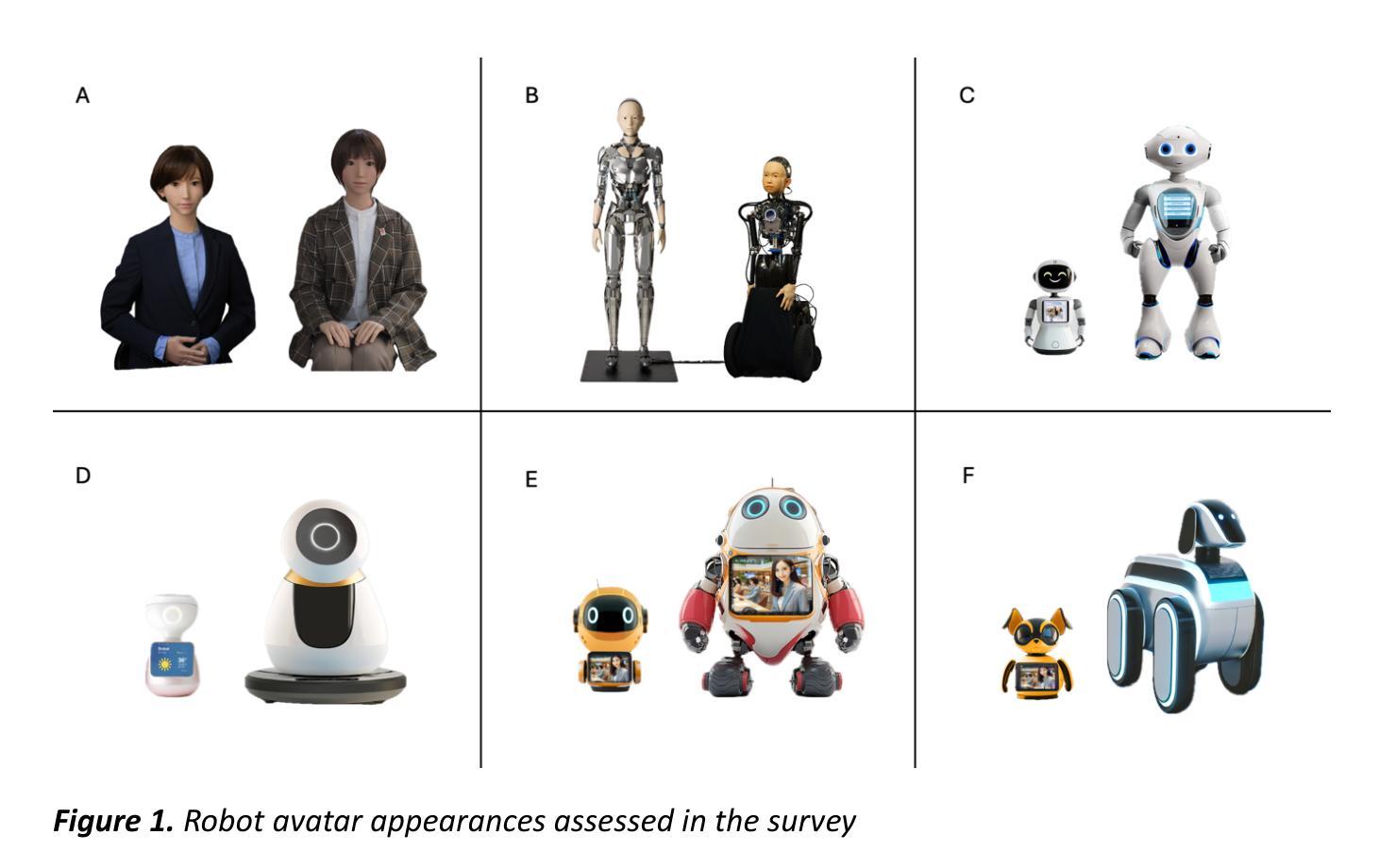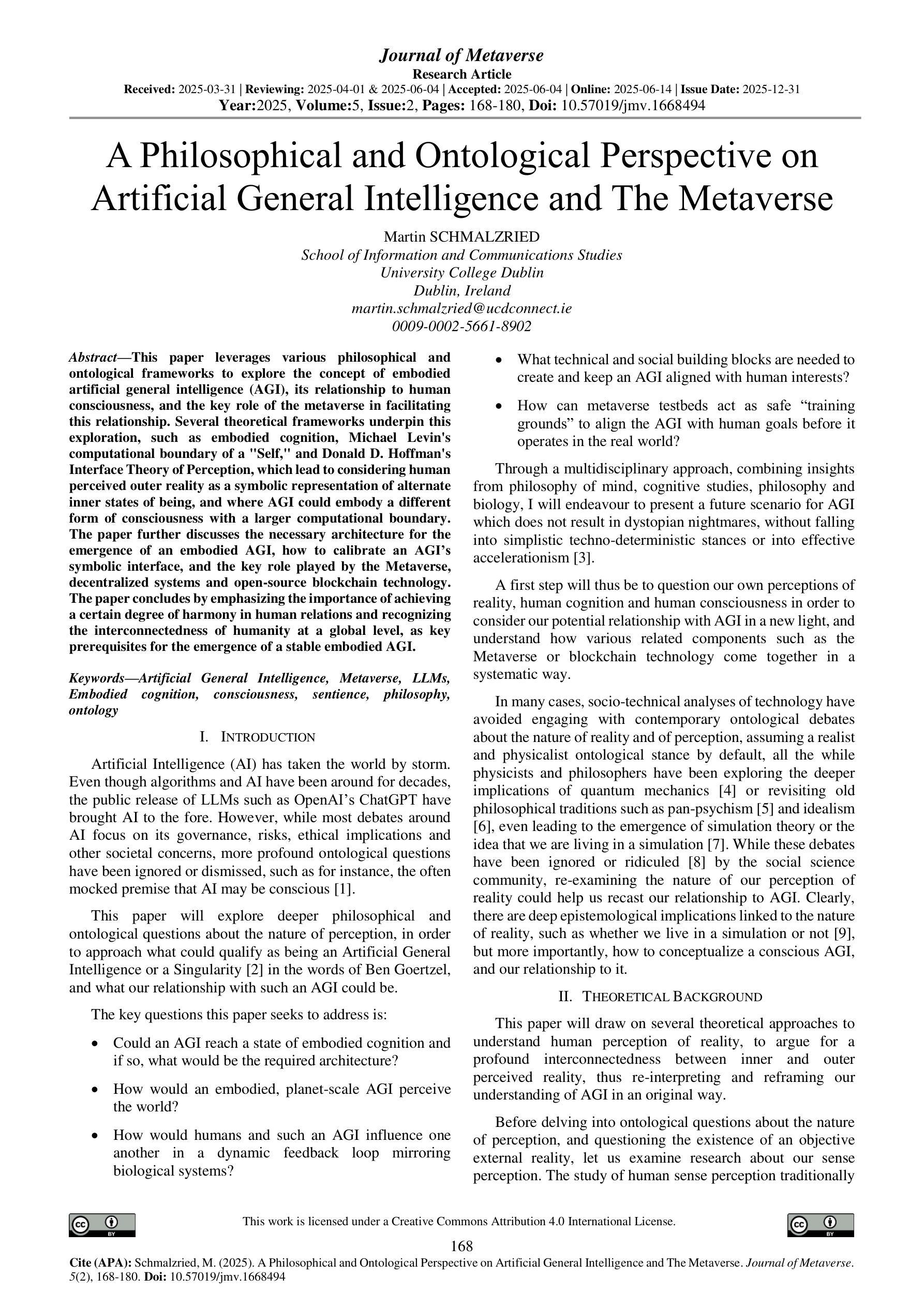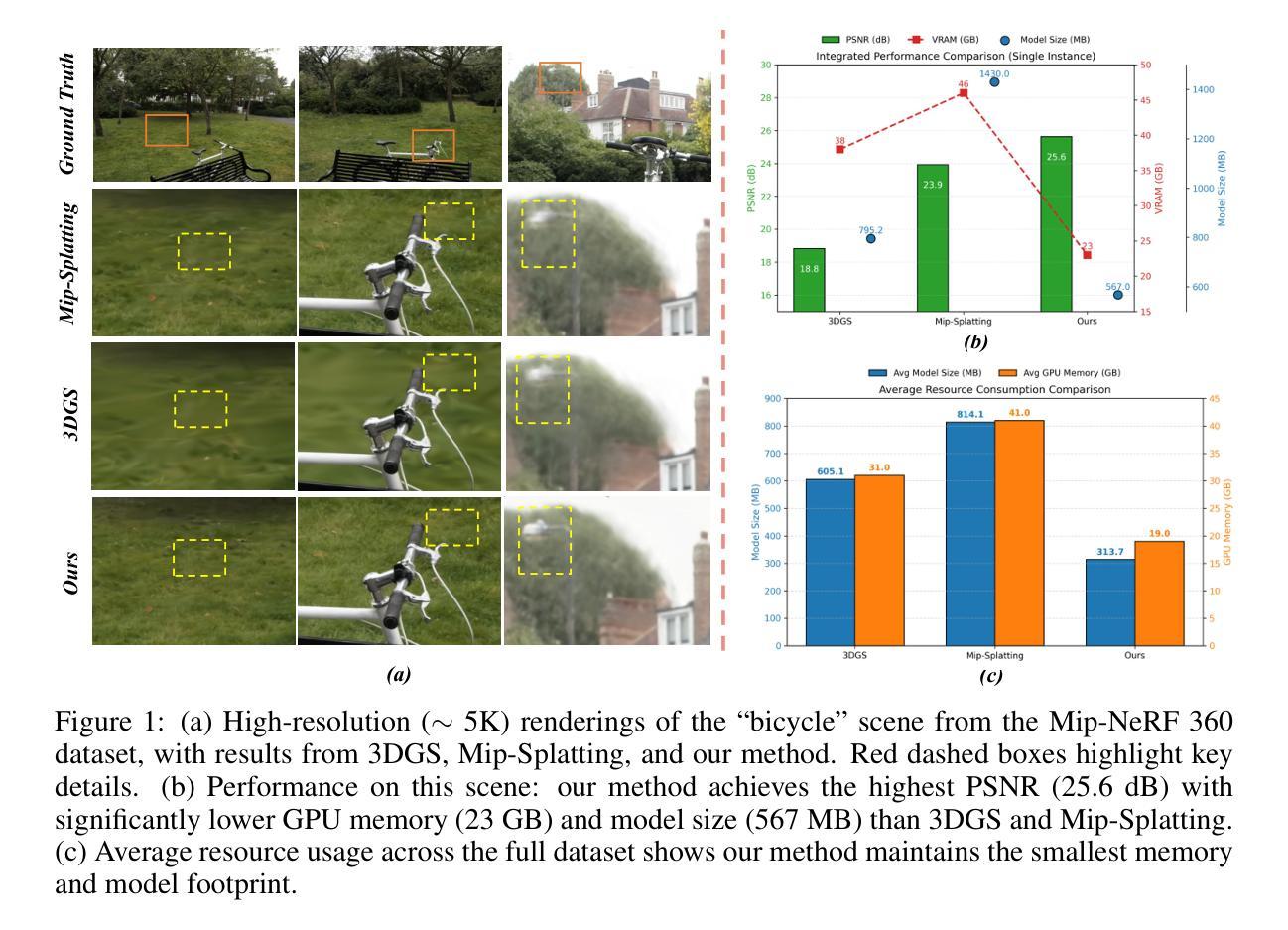⚠️ 以下所有内容总结都来自于 大语言模型的能力,如有错误,仅供参考,谨慎使用
🔴 请注意:千万不要用于严肃的学术场景,只能用于论文阅读前的初筛!
💗 如果您觉得我们的项目对您有帮助 ChatPaperFree ,还请您给我们一些鼓励!⭐️ HuggingFace免费体验
2025-06-22 更新
Public Acceptance of Cybernetic Avatars in the service sector: Evidence from a Large-Scale Survey in Dubai
Authors:Laura Aymerich-Franch, Tarek Taha, Takahiro Miyashita, Hiroko Kamide, Hiroshi Ishiguro, Paolo Dario
Cybernetic avatars are hybrid interaction robots or digital representations that combine autonomous capabilities with teleoperated control. This study investigates the acceptance of cybernetic avatars in the highly multicultural society of Dubai, with particular emphasis on robotic avatars for customer service. Specifically, we explore how acceptance varies as a function of robot appearance (e.g., android, robotic-looking, cartoonish), deployment settings (e.g., shopping malls, hotels, hospitals), and functional tasks (e.g., providing information, patrolling). To this end, we conducted a large-scale survey with over 1,000 participants. Overall, cybernetic avatars received a high level of acceptance, with physical robot avatars receiving higher acceptance than digital avatars. In terms of appearance, robot avatars with a highly anthropomorphic robotic appearance were the most accepted, followed by cartoonish designs and androids. Animal-like appearances received the lowest level of acceptance. Among the tasks, providing information and guidance was rated as the most valued. Shopping malls, airports, public transport stations, and museums were the settings with the highest acceptance, whereas healthcare-related spaces received lower levels of support. An analysis by community cluster revealed among others that Emirati respondents showed significantly greater acceptance of android appearances compared to the overall sample, while participants from the ‘Other Asia’ cluster were significantly more accepting of cartoonish appearances. Our study underscores the importance of incorporating citizen feedback into the design and deployment of cybernetic avatars from the early stages to enhance acceptance of this technology in society.
赛博化身是结合了自主能力与遥控控制的混合交互机器人或数字代表。本研究调查了迪拜多元文化社会中人们对赛博化身的接受程度,特别是客服机器人的赛博化身。我们探索了接受度如何作为机器人外观(例如,机械人、机器人外观、卡通风格)、部署环境(例如,购物中心、酒店、医院)和功能任务(例如,提供信息、巡逻)的函数而变化。为此,我们对超过1000名参与者进行了一项大规模调查。总体而言,赛博化身得到了高度的接受,实体机器人化身比数字化身得到了更高的接受度。在外观方面,具有高度拟人机器人外观的机器人化身最受青睐,其次是卡通设计和机械人。动物外观的接受度最低。在任务中,提供信息和指导被认为是最有价值的。购物中心、机场、公共车站和博物馆是接受度最高的环境,而医疗相关空间则获得较低的支持。通过社区集群分析发现,与其他集群相比,阿联酋的受访者对于机械人外观的接受度显著高于总体样本,而来自“其他亚洲”集群的参与者则更倾向于接受卡通风格的外观。我们的研究强调了从早期阶段就融入市民反馈对设计和部署赛博化身的重要性,以提高社会各界对这一技术的接受度。
论文及项目相关链接
PDF 25 pages, 3 Figures
摘要
本研究探讨了迪拜多元文化社会中对网络仿生角色的接受程度,特别是针对客户服务领域的机器人角色。研究探讨了接受度如何作为机器人外观、部署环境和工作功能的函数而变化。通过向1000多名参与者进行大规模调查,发现网络仿生角色得到了高度的接受,物理机器人角色比数字角色的接受度更高。在外观方面,高度拟人化的机器人形象最被接受,其次是卡通设计和机器人,动物形象接受度最低。就任务而言,提供信息和指导被认为是最有价值的服务项目。购物中心、机场、公共汽车站和博物馆是最受接受的环境,而医疗相关空间的支持度较低。社区聚类分析表明,阿联酋受访者对机器人的接受程度显著高于整体样本,而其他亚洲受访者更接受卡通外观的角色。本研究强调了在设计网络仿生角色部署过程中融入公民反馈的重要性,从早期阶段提升技术融入社会的接受度。
关键见解
- 迪拜社会高度接受网络仿生角色,尤其是物理机器人角色。
- 高度拟人化的机器人外观最受青睐,动物外观的接受度较低。
- 提供信息和指导是认可度最高的功能任务。
- 购物中心等特定部署环境对网络仿生角色的接受度较高,医疗空间接受度较低。
- 不同社区群体对网络仿生角色的接受程度存在差异,如阿联酋受访者更接受机器人外观的角色。
- 公民反馈在设计部署网络仿生角色时应被纳入考虑,以提高技术的社会接受度。
点此查看论文截图


A philosophical and ontological perspective on Artificial General Intelligence and the Metaverse
Authors:Martin Schmalzried
This paper leverages various philosophical and ontological frameworks to explore the concept of embodied artificial general intelligence (AGI), its relationship to human consciousness, and the key role of the metaverse in facilitating this relationship. Several theoretical frameworks underpin this exploration, such as embodied cognition, Michael Levin’s computational boundary of a “Self,” and Donald D. Hoffman’s Interface Theory of Perception, which lead to considering human perceived outer reality as a symbolic representation of alternate inner states of being, and where AGI could embody a different form of consciousness with a larger computational boundary. The paper further discusses the necessary architecture for the emergence of an embodied AGI, how to calibrate an AGI’s symbolic interface, and the key role played by the Metaverse, decentralized systems and open-source blockchain technology. The paper concludes by emphasizing the importance of achieving a certain degree of harmony in human relations and recognizing the interconnectedness of humanity at a global level, as key prerequisites for the emergence of a stable embodied AGI.
本文运用各种哲学和本体论框架来探讨具身通用人工智能(AGI)的概念,其与人类意识的关系,以及元宇宙在促进这种关系中的关键作用。本文的探究基于多个理论框架,如具身认知、迈克尔·莱文的“自我”计算边界理论以及唐纳德·D·霍夫曼的感知界面理论等。这些理论促使人们将人类感知到的外部现实视为存在状态的另一种形式的象征性表示,而AGI可能会体现具有更大计算边界的不同形式的意识。本文还进一步讨论了具身AGI出现的必要架构、如何校准AGI的符号界面以及在元宇宙、去中心化系统和开源区块链技术中所扮演的关键角色。最后,本文强调实现一定程度的人类关系和谐以及在全球层面认识到人类之间的相互联系是实现稳定具身AGI的关键先决条件。
论文及项目相关链接
PDF Presented at the conference second international conference on human-centred AI ethics: seeing the human in the artificial (HCAIE 2023): https://ethics-ai.eu/hcaie2023/ Revised version published in the Journal of Metaverse: https://dergipark.org.tr/en/pub/jmv/issue/91863/1668494
Summary
本文探讨了体现人工智能通用性(AGI)的概念,其与人类意识的关系,以及元宇宙在这一关系中的关键作用。文章借鉴了多种哲学和本体论框架,如具身认知、迈克尔·莱文的“自我”计算边界和唐纳德·D·霍夫曼的感知界面理论等,探讨了人类感知的外部现实作为不同内在状态存在的象征表示,以及AGI可能体现的不同形式的意识。此外,文章还讨论了构建体现AGI所需的结构、如何校准AGI的符号界面以及元宇宙、去中心化系统和开源区块链技术所扮演的关键角色。最后,文章强调实现人际关系的和谐以及认识到人类之间的互联性是全球层面实现稳定体现AGI的关键先决条件。
Key Takeaways
- 文章探讨了体现人工智能通用性(AGI)的概念及其与人类意识的关系。
- 文章通过哲学和本体论框架分析了AGI的具身性。
- 提到了几个理论框架如具身认知、迈克尔·莱文的“自我”计算边界和唐纳德·D·霍夫曼的感知界面理论等用于探讨AGI和人类意识的关系。
- AGI可能体现不同形式的意识,具有更大的计算边界。
- 元宇宙在促进AGI的出现和发展中起到了关键作用。
- 构建体现AGI需要特定的架构,并需要校准AGI的符号界面。
点此查看论文截图


